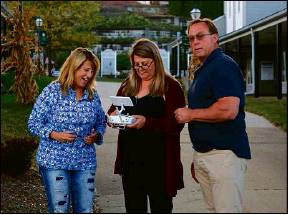‘WATCH YOUR ALTITUDE!’
Drone education in Somerset
RICK KAZMER
rickk@dailyamerican.com
David Lee Devan was an aviator in the military when the Predator drone first shared the skies with the aircraft he was piloting.
“It’s amazing,” he said of the advancements in drone technology since the early 1990s. He also recalls being a little uneasy about how the Predator, the size of a car, was going to react in the early years.
Now drones the size of a book are on sale at Walmart. Devan and Mike Knapp are instructors in a growing drone industry they liken to the Wild West.
of students how to pilot drones as part of a 32-hour course offered by Allegany College of Maryland at the Georgian Place in Somerset.
As Devan explained some of the technology, with one eye on a nearby student, he regularly offered guidance to the pupil.
“Watch your altitude!”
“Bring it down to 300.”
It’s a mix of military lingo, aviation skill and gamer instincts.
The drones used Wednesday cost a few grand. They were operated with handheld controllers with two joysticks and a high-definition screen.
Knapp said he has had gamers and seasoned pilots as students. Sometimes the gamers outperform the pilots because the controls are similar to an Xbox or PlayStation.
These drones carry high-quality cameras that can shoot photos and video. Knapp said pilots must know a little information technology and gain aviation knowledge to pass the Federal Aviation Administration test, required for any drone pilot using the aircraft as part of a business.
“It’s all wrapped up in the drone,” Knapp said. “It makes for an exciting part of the business.”
Knapp and Devan are with Eye in The Sky, a division of Szanca Solutions of Bedford. The business is working with ACM to offer the course, which has also been taught in Bedford and Cumberland, Maryland.
Knapp said the FAA test costs $150. The course, which is approximately $575, includes 16 hours of classroom time and 16 hours of flight time. He said they have a 100% pass rate.
The students on Wednesday included real estate agents, photographers, an employee with a local manufacturing company and a hobbyist.
“I think we all have enjoyed getting out here and flying the drone,” said Eric Knopsnyder, who is taking the course for Riggs Industries.
Brenda Torrey, who is in the real estate business and also enjoys photography, said she has heard the FAA test is hard.
“I think that’s why we took the class,” she said.
The students were practicing takeoffs, flight maneuvers and landings. Devan showcased some unique tasks the drones are capable of completing. While the drone was a few hundred feet in the air, he used his finger to trace a flight path on the screen of the controller. The drone then followed the path he created with his fingertip. They are surprisingly responsive. But it’s easy to see why one small mistake with your thumb can send the costly machine into a nosedive.
Insurance and real estate agents use drones to inspect and showcase properties. Farmers are using them to assess fields and to keep track of their cattle. In those cases, all are required by law to be licensed.
Eye in the Sky uses the high-tech cameras for photography, to complete surveys and for search and rescue, among other services. Knapp said he thinks the industry is only going to expand as tech giants such as Amazon broaden their use while smaller-business owners find ways to maximize the technology.
“I think it is,” he said, noting that drones are not just for taking photos and delivering pizzas. “You will see more and more of them. For myself, I inspect my cattle.”
Even while flying over the Georgian Place and the drawn-down Somerset Lake, the students had to be aware of airspace. The instructors said medical helicopters fly in the area. The two were in constant communication about where the drones were in the air as students completed tasks. FAA rules state that drones can fly only up to 400 feet. If they are inspecting a structure, the drone can fly 400 feet above the top of the structure. Knapp said drones can move quickly, 45 mph to 100 mph, depending on make and model.
“I think you will see these evolve as they get better and safer,” he said. “A lot of people will be using them to make jobs safer and better.”
Rob Coleman, a retired hobbyist, is taking the course not for business needs, but out of curiosity.
“I like this because it’s an opportunity to get in on a ground-floor technology,” he said.
The students will continue their training for a few more weeks before taking the test.



